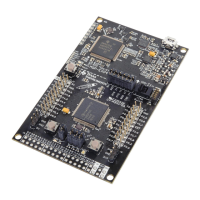Controller Area Network (CAN)
configuration of a message object. Reading the message object using this function will also clear
any pending interrupt on the message object.
Once a message object has been configured using ROM_CANMessageSet(), it has allocated the
message object and will continue to perform its programmed function unless it is released with a
call to ROM_CANMessageClear(). The application is not required to clear out a message object
before setting it with a new configuration, because each time ROM_CANMessageSet() is called, it
will overwrite any previously programmed configuration.
The 32 message objects are identical except for priority. The lowest numbered message objects
have the highest priority. Priority affects operation in two ways. First, if multiple actions are ready
at the same time, the one with the highest priority message object will occur first. And second,
when multiple message objects have interrupts pending, the highest priority will be presented first
when reading the interrupt status. It is up to the application to manage the 32 message objects as
a resource, and determine the best method for allocating and releasing them.
The CAN controller can generate interrupts on several conditions:
When any message object transmits a message
When any message object receives a message
On warning conditions such as an error counter reaching a limit or occurrence of various bus
errors
On controller error conditions such as entering the bus-off state
Once CAN interrupts are enabled, the handler will be invoked whenever a CAN interrupt is triggered.
The handler can determine which condition caused the interrupt by using the ROM_CANIntStatus()
function. Multiple conditions can be pending when an interrupt occurs, so the handler must be
designed to process all pending interrupt conditions before exiting. Each interrupt condition must be
cleared before exiting the handler. There are two ways to do this. The ROM_CANIntClear() function
will clear a specific interrupt condition without further action required by the handler. However,
the handler can also clear the condition by performing certain actions. If the interrupt is a status
interrupt, the interrupt can be cleared by reading the status register with ROM_CANStatusGet().
If the interrupt is caused by one of the message objects, then it can be cleared by reading the
message object using ROM_CANMessageGet().
There are several status registers that can be used to help the application manage the controller.
The status registers are read using the ROM_CANStatusGet() function. There is a controller status
register that provides general status information such as error or warning conditions. There are also
several status registers that provide information about all of the message objects at once using a
32-bit bit map of the status, with one bit representing each message object. These status registers
can be used to determine:
Which message objects have unprocessed received data
Which message objects have pending transmission requests
Which message objects are allocated for use
6.2 Functions
Functions
uint32_t ROM_CANBitRateSet (uint32_t ui32Base, uint32_t ui32SourceClock, uint32_t
ui32BitRate)
54 April 8, 2013

